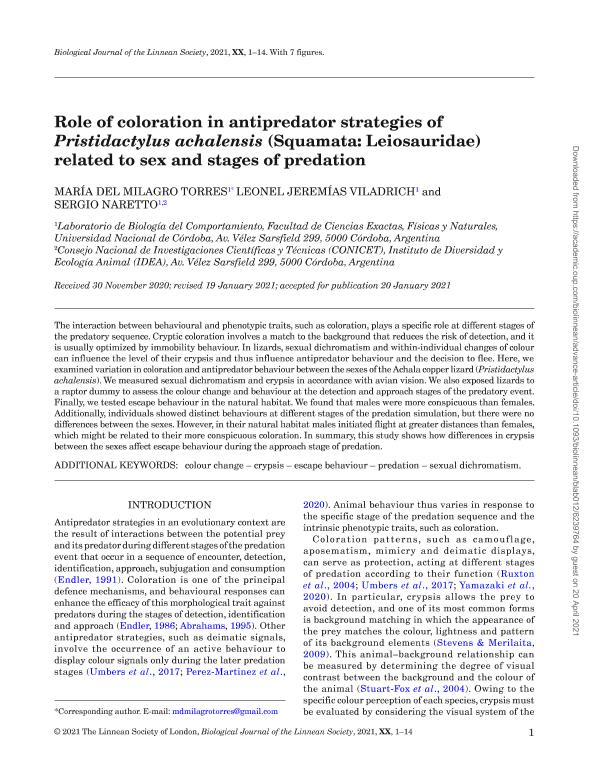Mostrar el registro sencillo del ítem
dc.contributor.author
Torres, María del Milagro

dc.contributor.author
Viladrich, Leonel Jeremías

dc.contributor.author
Naretto, Sergio

dc.date.available
2022-10-28T10:54:33Z
dc.date.issued
2021-04-20
dc.identifier.citation
Torres, María del Milagro; Viladrich, Leonel Jeremías; Naretto, Sergio; Role of coloration in antipredator strategies of Pristidactylus achalensis (Squamata: Leiosauridae) related to sex and stages of predation; Wiley Blackwell Publishing, Inc; Biological Journal of The Linnean Society; 133; 3; 20-4-2021; 896-909
dc.identifier.issn
0024-4066
dc.identifier.uri
http://hdl.handle.net/11336/175294
dc.description.abstract
The interaction between behavioural and phenotypic traits, such as coloration, plays a specific role at different stages of the predatory sequence. Cryptic coloration involves a match to the background that reduces the risk of detection, and it is usually optimized by immobility behaviour. In lizards, sexual dichromatism and within-individual changes of colour can influence the level of their crypsis and thus influence antipredator behaviour and the decision to flee. Here, we examined variation in coloration and antipredator behaviour between the sexes of the Achala copper lizard (Pristidactylus achalensis). We measured sexual dichromatism and crypsis in accordance with avian vision. We also exposed lizards to a raptor dummy to assess the colour change and behaviour at the detection and approach stages of the predatory event. Finally, we tested escape behaviour in the natural habitat. We found that males were more conspicuous than females. Additionally, individuals showed distinct behaviours at different stages of the predation simulation, but there were no differences between the sexes. However, in their natural habitat males initiated flight at greater distances than females, which might be related to their more conspicuous coloration. In summary, this study shows how differences in crypsis between the sexes affect escape behaviour during the approach stage of predation.
dc.format
application/pdf
dc.language.iso
eng
dc.publisher
Wiley Blackwell Publishing, Inc

dc.rights
info:eu-repo/semantics/openAccess
dc.rights.uri
https://creativecommons.org/licenses/by-nc-sa/2.5/ar/
dc.subject
COLOUR CHANGE
dc.subject
CRYPSIS
dc.subject
ESCAPE BEHAVIOUR
dc.subject
PREDATION
dc.subject
SEXUAL DICHROMATISM
dc.subject.classification
Ecología

dc.subject.classification
Ciencias Biológicas

dc.subject.classification
CIENCIAS NATURALES Y EXACTAS

dc.title
Role of coloration in antipredator strategies of Pristidactylus achalensis (Squamata: Leiosauridae) related to sex and stages of predation
dc.type
info:eu-repo/semantics/article
dc.type
info:ar-repo/semantics/artículo
dc.type
info:eu-repo/semantics/publishedVersion
dc.date.updated
2022-09-21T15:21:59Z
dc.journal.volume
133
dc.journal.number
3
dc.journal.pagination
896-909
dc.journal.pais
Reino Unido

dc.journal.ciudad
Londres
dc.description.fil
Fil: Torres, María del Milagro. Universidad Nacional de Córdoba. Facultad de Cs.exactas Físicas y Naturales. Departamento de Diversidad Biológica y Ecológica. Cátedra de Biología del Comportam. y Div. Animal Ii; Argentina. Consejo Nacional de Investigaciones Científicas y Técnicas; Argentina
dc.description.fil
Fil: Viladrich, Leonel Jeremías. Universidad Nacional de Córdoba. Facultad de Cs.exactas Físicas y Naturales. Departamento de Diversidad Biológica y Ecológica. Cátedra de Biología del Comportam. y Div. Animal Ii; Argentina. Consejo Nacional de Investigaciones Científicas y Técnicas; Argentina
dc.description.fil
Fil: Naretto, Sergio. Consejo Nacional de Investigaciones Científicas y Técnicas. Centro Científico Tecnológico Conicet - Córdoba. Instituto de Diversidad y Ecología Animal. Universidad Nacional de Córdoba. Facultad de Ciencias Exactas Físicas y Naturales. Instituto de Diversidad y Ecología Animal; Argentina
dc.journal.title
Biological Journal of The Linnean Society

dc.relation.alternativeid
info:eu-repo/semantics/altIdentifier/url/https://academic.oup.com/biolinnean/article/133/3/896/6239764
dc.relation.alternativeid
info:eu-repo/semantics/altIdentifier/doi/https://doi.org/10.1093/biolinnean/blab012
Archivos asociados
